Sexual Orientation
Last Modified 20/03/2023 14:45:17
Share this page
Introduction
Blackpool has one of the largest LGBTQ+ communities in the UK, with a large number of gay owned and gay friendly hotels, bars, clubs and business. Until recently, however, there has been limited official data about people who are LGBT+: lesbian, gay, bisexual, transgender, queer or who identify as other sexualities (with the exception of straight / heterosexual).
For the first time, the 2021 census asked questions about the population’s sexual orientation and gender identity. These census questions were voluntary, only asked of those aged 16 years and over, and only capture the responses of those who were willing or able to disclose their sexual orientation or gender identity. However, whilst national estimates have previously been published by the ONS, this census data provides the most comprehensive data yet about the national and local adult population.
Sexual Orientation
Sexual orientation is a term used to cover sexual identity, attraction and behaviour. For different individuals these may not be the same, and statistics drawn from the census should only be interpreted as showing how people responded to the question.
The census question about sexual identity was voluntary and was only asked of people aged 16 years and over. The full population (including young people) of those who identify as lesbian, gay, bisexual or other sexual orientation (LGB+) will therefore be greater than reported figures.
Across England and Wales 44.9 million people responded to the sexual orientation question, 92.5% of the population of those age 16 years and over. In Blackpool 93.3% of people responded to the question.
Around 1.5 million (3.2%) people across England and Wales identified as gay, lesbian, bisexual or another sexual orientation. Around 748,000 (1.5%) identified as gay or lesbian, while 628,000 (1.3%) identified as bisexual. A further 165,000 identified with a different sexual orientation, with the most common ‘other’ orientations provided in the write-in box that allowed for self-identification being pansexual (112,000 people), asexual (28,000 people) and Queer (15,000 people).
Census 2021 statistics for Blackpool show that:
- 102,898 (88.4%) of the Blackpool population aged 16 years and over identified as straight or heterosexual, with a further 6.7% (7,749) not answering the sexual orientation question (Figure 1)
- 5,692 (4.9%) people aged 16 years and over identified as having a LGB+ sexual orientation
- This compares to 3.2% of the population identifying as LGB+ across England and the North West region
- 3,794 people (3.3% of the population) identified as Gay or Lesbian, and 1,572 (1.4%) identified as Bisexual
- The proportion of the population identifying as Gay or Lesbian is more than double the England average (3.3% compared to 1.5%)
- The proportion of those identifying as bisexual is slightly higher than the England average (1.4% compared to 1.3%), whilst the proportion of those with ‘other sexual orientations’ (pansexual, asexual, Queer and others) is similar to England.
Figure 1: Reported Sexual Orientation in Blackpool, North West and England – Census 2021 (proportions of population)
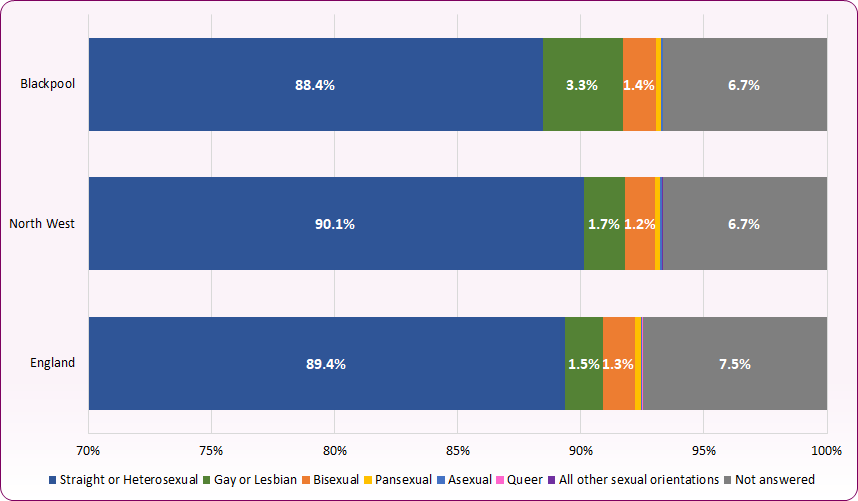 Source: Office for National Statistics (ONS), Census 2021
Source: Office for National Statistics (ONS), Census 2021
The Blackpool LGB+ population varies by both age and gender. 3,175 Blackpool residents in Census 2021 identified as LGB+ males (56% of the LGB+ population), and 2,520 as females (Figure 2).
Figure 2: Reported numbers of LGB+ population, Blackpool - Census 2021 (numbers of population)
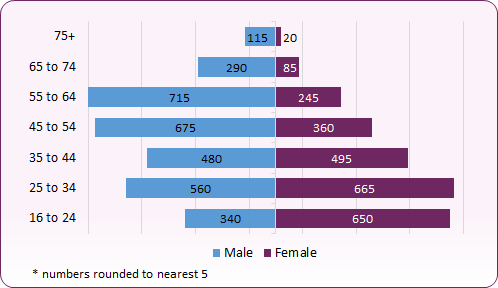 Source: Office for National Statistics (ONS), Census 2021
Source: Office for National Statistics (ONS), Census 2021
Similar to the national picture, the female LGB+ identifying population in Blackpool tends to be younger, with 9.9% of the female 16-24 population identifying as LGB+ compared to 2.4% of 55 to 64 year olds, 1.1% of 65 to 74 year olds and 0.3% of those aged 75+ (Figure 3).
Figure 3: Proportion of LGB+ Population, Blackpool and England - Census 2021
 Source: Office for National Statistics (ONS), Census 2021
Source: Office for National Statistics (ONS), Census 2021
As might be expected, the LGB+ population lives across Blackpool, though is more concentrated in central coastal areas such as North Shore (MSOA006), where 11.5% of the population identified as LGB+, and Central Blackpool (MSOA010), where 9.1% identified as LGB+ (Figure 4). The proportions of people identifying as Lesbian and Gay in North Shore (8.3%) and Central (6%) are among the highest in the country alongside areas of Brighton, Manchester, Salford and London.
Figure 4: Proportion of LGB+ population in Blackpool, by Lower Super Output Area (and Ward Boundaries)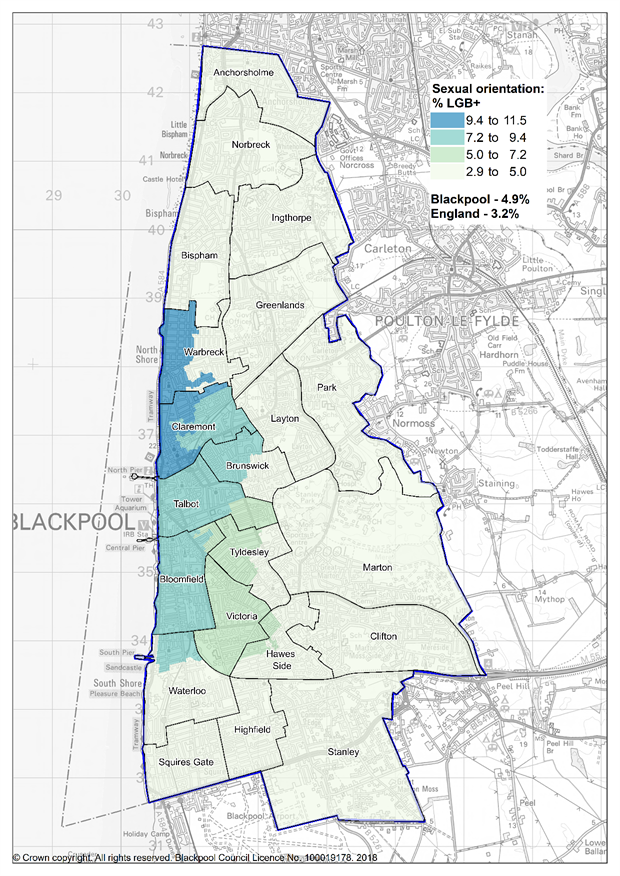 Source: ONS, Census 2021
Source: ONS, Census 2021
Gender Identity
Gender identity refers to a person’s sense of their own gender, whether male, female or another category such as non-binary. As with the question about sexual orientation, the question about gender identity was new for Census 2021, and there is little other reliable data about the UK population's self-identified gender identity at national or local levels.
The Census 2021 question was voluntary and only asked of those aged 16 years and over. People were asked “Is the gender you identify with the same as your sex registered at birth?” and had the option of responding ‘yes’, or selecting ‘no’ and writing in their gender identity.
45.7 million people across England and Wales responded to the census question (94% of the population aged 16 years and over). 45.4 million (93.5%) answered ‘yes’ indicating that their gender identity was the same as their sex registered at birth.
262,000 people (0.5%) answered ‘no’ indicating that their gender identity was different from their sex at birth. 118,000 did not provide any further written response to further clarify their identify, 48,000 (0.1% of the population) identified as a trans man, 48,000 (0.1%) identified as a trans woman, 30,000 (0.06%) identified as non-binary, and 18,000 entered a range of other gender identities.
In Blackpool, Census 2021 data suggests that, among those aged 16 and above:
- 677 people (0.58%) reported having a gender identity different from their sex at birth – slightly higher than the proportion across England (0.55%) and the North West (0.5%) (Figure 5).
- Proportions of trans men (0.12%), trans women (0.11%) and those reporting no specific gender identity (0.27%) were slightly higher than national and regional population proportions.
- As with the national picture, the proportion of those with a gender identity different from sex at birth is higher among the younger population (1.2% among 16 to 24s, 0.7% among 25 to 34s, and 0.8% among 35 to 44s) (Figure 6)
- The proportion of the population of those whose gender identity is different from sex registered at birth varies across Blackpool, with 1.37% in Central Blackpool (MSOA 010) and 1.28% in North Shore (MSOA 006).
Figure 5: Gender identity among those reporting a different gender from their sex at birth, Blackpool - Census 2021
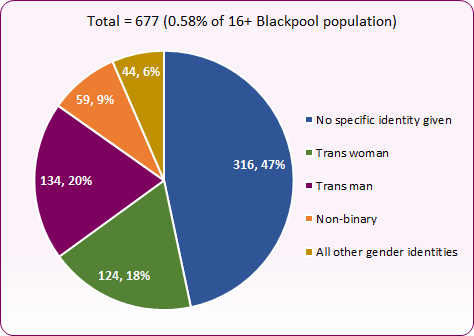 Source: Office for National Statistics (ONS), Census 2021
Source: Office for National Statistics (ONS), Census 2021
Figure 6: Number (and proportion of population) of people reporting gender identity different from sex registered at birth, Blackpool - Census 2021
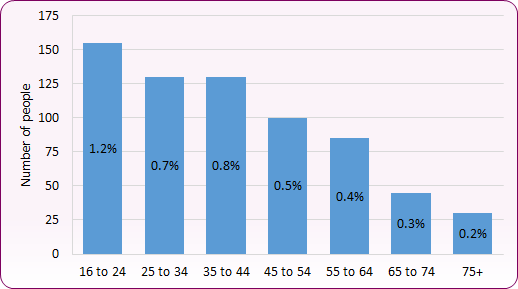 Source: Office for National Statistics (ONS), Census 2021
Source: Office for National Statistics (ONS), Census 2021
National and Local Policies and Initiatives
Census 2021 data enables a greater awareness of, and scrutiny around equality issues relating to sexual orientation and gender identity in the workplace and wider society, in line with the Equalities Act 2010. It also can help to support resource allocation and policy development in this area.
At a local level, Blackpool organisations and services are involved in a range of strategic and operational elements that seek to ensure the needs of LGBTQ+ people across Blackpool are understood and effectively met. These include: